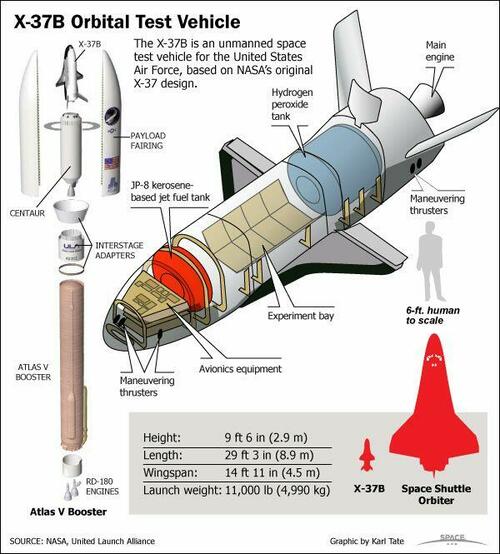The US Space Force's Boeing X-37B unmanned, reusable space plane successfully deorbited after a record-breaking orbital mission around Earth and landed at NASA's Kennedy Space Center Shuttle Landing Facility on Saturday.
The robotic X-37B landed at 0533 ET after spending 908 days in orbit -- more than four months longer than the previous mission.
It's the sixth Orbital Test Vehicle mission (OTV-6) with top-secret payloads that military researchers were testing in low-Earth orbit.
Even though most of the payloads are classified, some have been made public, such as the US Naval Research Laboratory's Photovoltaic Radio-frequency Antenna Module, a small device that converts solar power into radio frequency microwave energy.
Space.com expanded more on the non-classified experiments and technologies being tested:
"Technologies being tested in the X-37B program include advanced guidance, navigation and control, thermal protection systems, avionics, high temperature structures and seals, conformal reusable insulation, lightweight electromechanical flight systems, advanced propulsion systems, advanced materials and autonomous orbital flight, re-entry and landing."
Task & Purpose has speculated some of the mysterious payloads could be "testing surveillance systems to experiments on putting satellites in lower orbits."
After the space plane landed, Jim Chilton, senior vice president at Boeing Space and Launch, wrote:
"With the service module added, this was the most we've ever carried to orbit on the X-37B, and we're proud to have been able to prove out this new and flexible capability for the government and its industry partners."
Space Force stated that "NASA scientists will leverage data collected after the materials have spent 900+ days in orbit and compare observed effects to ground simulations, validating and improving the precision of space environment models."
"The X-37B continues to push the boundaries of experimentation, enabled by an elite government and industry team behind the scenes.
"The ability to conduct on-orbit experiments and bring them home safely for in-depth analysis on the ground has proven valuable for the Department of the Air Force and scientific community. The addition of the service module on OTV-6 allowed us to host more experiments than ever before," Lt. Col. Joseph Fritschen, DAF Rapid Capabilities Office's X-37B Program Director, said.
The X-37B is similar to the retired space shuttle, although the space plane is a fraction of the size, coming in at 29 feet in length and 9.5 feet high, with a wingspan of 15 feet.
Here's a list of the prior X-37 B's top-secret missions in low-Earth obit:
- OTV-1: launched on Apr. 22, 2010 and landed on Dec. 3, 2010, spending over 224 days in orbit.
- OTV-2: launched on Mar. 5, 2011 and landed on Jun. 16, 2012, spending over 468 days in orbit.
- OTV-3: launched on Dec. 11, 2012 and landed on Oct. 17, 2014, spending over 674 days in orbit.
- OTV-4: launched on May 20, 2015 and landed on May 7, 2015, spending nearly 718 days in orbit.
- OTV-5: launched on Sept. 7, 2017 and landed on Oct. 27, 2019, spending nearly 780 days in orbit.
- OTV-6: launched on May 17, 2020 and landed on Nov. 12, 2022, spending over 908 days in orbit.
There are rumors the X-37B might be a testbed for space weapons or could be used to capture adversary satellites...
via zerohedge


